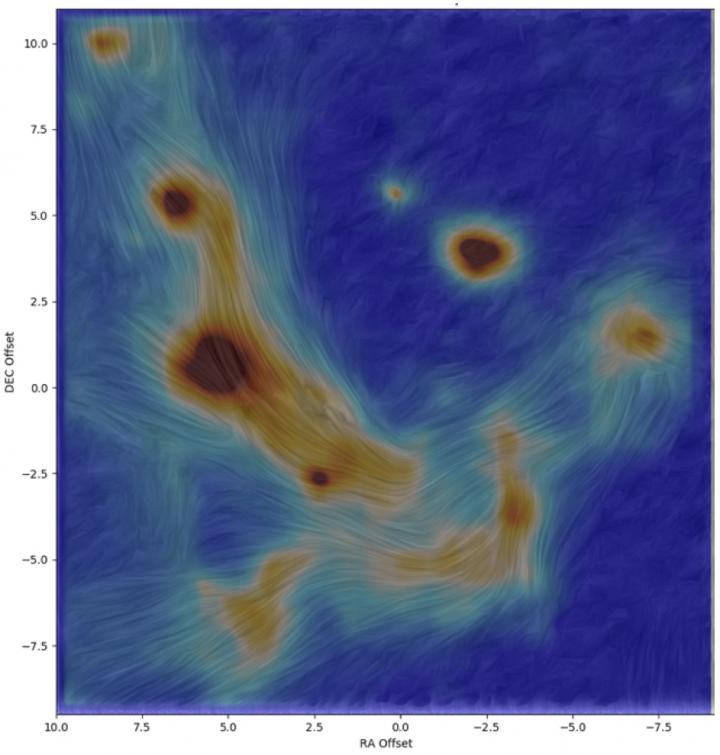New research reveals clearest infrared image yet of the center of our galaxy

This image is a new high-resolution map of the magnetic field lines in gas and dust swirling around the supermassive black hole at the center of our galaxy. Credit: Oxford University/Royal Astronomical Society/UTSA
“This collaborative work is an exciting step forward in our collective efforts to gain a greater understanding of our own galaxy and the super-massive black hole at the center of it. It also demonstrates the importance of access to the largest telescopes using advanced cameras/techniques,” Packham said.
Black holes are objects with gravitational fields so strong that even light cannot escape their grasp. The center of almost every galaxy appears to host a black hole, including the Milky Way, where we live. Stars move around the black hole at speeds of up to 800 million kilometres an hour, indicating that it has a mass of at least a million times our Sun. Depending on how the material flows, some of it may eventually be captured and engulfed by the black hole.
Visible light from sources in the center of the Milky Way is blocked by clouds of gas and dust. Infrared light, as well as X-rays and radio, more freely passes through this obscuring material, so astronomers use this to see the region more clearly. CanariCam combines this with a polarising device, which preferentially filters light with the particular characteristics associated with magnetic fields.
“This work, in addition to its scientific relevance, is very important to the advancement of the Ph.D. physics and astronomy program here at UTSA, since it involves students in cutting edge research,” said Miguel Jose Yacaman, professor and Lutcher Brown Endowed Chair of the UTSA Department of Physics and Astronomy.
Centered on the supermassive black hole, the new infrared map covers a region about one light year on each side. The image shows the intensity of infrared light, and traces magnetic field lines within filaments of warm dust grains and hot gas, which appear here as thin lines reminiscent of brush strokes in a painting.
The filaments, several light years long, appear to meet close to the black hole and may indicate where orbits of streams of gas and dust converge. One prominent feature links some of the brightest stars in the center of the galaxy. Despite the strong winds flowing from these stars, the filaments remain in place, bound by the magnetic field within them. Elsewhere the magnetic field is less clearly aligned with the filaments.
The new observations give astronomers more detailed information on the relationship between the bright stars and the dusty filaments. The origin of the magnetic field in this region is not understood, but it is likely that a smaller magnetic field is stretched out as the filaments are elongated by the gravitational influence of the black hole and stars in the galactic center.
“Big telescopes like GTC, and instruments like CanariCam, deliver real results,” Roche said. “We're now able to watch material race around a black hole 25,000 light years away, and for the first time see magnetic fields there in detail.”
Media Contact
All latest news from the category: Physics and Astronomy
This area deals with the fundamental laws and building blocks of nature and how they interact, the properties and the behavior of matter, and research into space and time and their structures.
innovations-report provides in-depth reports and articles on subjects such as astrophysics, laser technologies, nuclear, quantum, particle and solid-state physics, nanotechnologies, planetary research and findings (Mars, Venus) and developments related to the Hubble Telescope.
Newest articles

High-energy-density aqueous battery based on halogen multi-electron transfer
Traditional non-aqueous lithium-ion batteries have a high energy density, but their safety is compromised due to the flammable organic electrolytes they utilize. Aqueous batteries use water as the solvent for…

First-ever combined heart pump and pig kidney transplant
…gives new hope to patient with terminal illness. Surgeons at NYU Langone Health performed the first-ever combined mechanical heart pump and gene-edited pig kidney transplant surgery in a 54-year-old woman…

Biophysics: Testing how well biomarkers work
LMU researchers have developed a method to determine how reliably target proteins can be labeled using super-resolution fluorescence microscopy. Modern microscopy techniques make it possible to examine the inner workings…





















